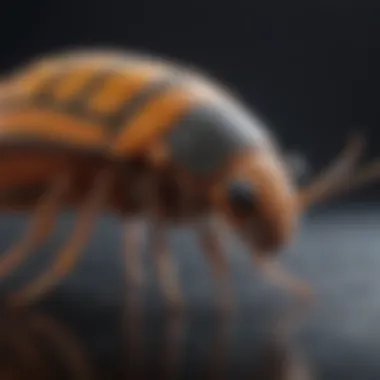Essential Guide to Rapid Response Pest Control Services for Urgent Issues


Preventive Pest Control Strategies
When it comes to keeping your home pest-free, implementing preventive pest control strategies is key. Starting with the house exterior, sealing cracks is essential to prevent pests from finding their way inside. Clearing debris from around your property not only enhances its appearance but also eliminates potential hiding spots for pests. To further deter pests from entering your home, consider investing in quality screens for doors and windows. Moving on to yard maintenance, routine care such as mowing the lawn, trimming bushes, and removing standing water helps minimize pest attraction. Indoors, maintaining cleanliness is crucial; adopt expert cleaning tips to remove spills, crumbs, and other potential food sources for pests. Additionally, keep clutter to a minimum to reduce hiding spots. Proper garbage disposal is another vital aspect; ensuring bins have tight-fitting lids and disposing of waste promptly helps avoid pest infestations. Explore innovative ways such as using repellent plants or installing ultrasonic pest repellents to safeguard your home further.
Identifying Pest Risk Areas
To effectively tackle pests, identifying risk areas in and around your home is paramount. Start with inspecting moisture-prone areas like basements and crawl spaces for any signs of water damage, as damp conditions attract pests like termites and cockroaches. Inspecting cracks and crevices in walls and around windows and doors helps uncover potential entry points for pests; sealing these openings with caulk or weather stripping is crucial. Assessing the impact of greenery on pest attraction is also essential; overgrown plants close to your home can serve as pathways for pests. Additionally, be vigilant in checking miscellaneous areas such as attics and storage spaces for pest activity, implementing preventive measures accordingly.
Effective Pest Control Methods
When preventive measures are not sufficient, understanding effective pest control methods is vital for managing infestations. Consider natural repellents like peppermint oil, vinegar, or cedarwood to deter pests without harsh chemicals. However, for more severe infestations, chemical sprays may be necessary; use professional products safely and according to instructions to eradicate pests effectively. Utilizing traps can also be effective, with options for live catch and kill traps available for various pests. Biological control methods involve introducing natural predators like ladybugs or nematodes to your garden to combat pests eco-friendly. Explore other methods such as heat treatment or electronic pest repellers for a comprehensive pest control approach.
Pest Species Identification
Different pest species require specific management strategies for effective control. Common insects like ants, cockroaches, and spiders can be challenging to eliminate once infestations occur; promptly identifying and addressing them is crucial. Rodents such as mice and rats are not only destructive but also carry diseases, making early detection and prevention vital. Bird species can also impact home environments negatively, with some causing damage to property or posing health risks. In cases of wildlife encounters on your property, understanding behavior patterns and implementing effective control measures is essential for safety. Moreover, lesser-known pests should not be overlooked, as they can still cause significant damage to your home.
DIY Pest Control Techniques
For those preferring a hands-on approach to pest control, DIY techniques offer practical solutions. Create homemade remedies using ingredients like vinegar, baking soda, or citrus peels to repel and eliminate pests naturally. Essential oils such as lavender, citronella, or tea tree oil can also be effective in warding off insects. Setting up traps and barriers using household items like jars or cardboard can help capture and remove pests safely. Explore reputable pest control brands that offer eco-friendly products for environmentally conscious pest management. Additionally, innovative DIY solutions like using fermented fruit juice to deter insects or planting pest-repelling herbs can contribute to a pest-free living environment.
Introduction
As we embark on the journey of delving into the realm of emergency pest control services, it is vital to recognize the significance of swift and efficient pest management in safeguarding our living spaces. Immediate action in the face of pest infestations can prevent potential damage to property and ensure the well-being of residents. This comprehensive guide aims to shed light on the essential steps and strategies required to address urgent pest-related issues effectively and expediently.
Understanding Emergency Pest Control Services
Definition of Emergency Pest Control
The definition of emergency pest control encompasses the rapid response and intervention necessary to curb pest infestations in critical situations. This aspect focuses on the urgency of managing pest issues promptly to prevent escalation and mitigate risks to residents and property. The key characteristic of emergency pest control lies in its immediate nature, tailored to address acute pest-related emergencies swiftly. This proactive approach ensures that pest problems are tackled promptly, reducing the potential for extensive damage. While the advantage of emergency pest control is its ability to provide quick solutions, a potential disadvantage could be the need for specialized expertise and resources to manage urgent pest situations effectively.
Significance of Immediate Pest Management
Immediate pest management plays a pivotal role in maintaining the safety and hygiene of living environments. By addressing pest issues promptly, the spread of pests and associated health risks can be minimized significantly. The key characteristic of immediate pest management lies in its proactive approach to containing pest infestations before they worsen. This swift action is crucial in preserving the integrity of structures and preventing potential health hazards. The unique feature of immediate pest management is its ability to offer rapid solutions, ensuring a swift resolution to pest-related emergencies. While the advantages include timely intervention and risk minimization, the potential disadvantage may involve the need for continual monitoring and follow-up to prevent future infestations.
Common Pest Infestations Requiring Urgent Intervention
Rodent Infestation


The presence of rodents in a home or commercial space necessitates urgent intervention to protect the property and inhabitants. Rodent infestations pose significant health risks due to the potential spread of diseases and contamination. The key characteristic of rodent infestation lies in the rapid reproduction rates and destructive behavior of rodents, making prompt eradication essential. Addressing rodent infestations promptly is crucial to safeguarding the environment and preventing structural damage. The unique feature of rodent infestation management is its focus on non-toxic eradication methods, minimizing risks to residents and pets. While the advantage of swift response to rodent infestations is effective pest control, a potential disadvantage could be the recurring nature of rodent populations.
Insect Infestation
Insects infesting a property demand immediate attention to prevent widespread infestation and potential health concerns. Insect infestations can quickly multiply and invade multiple areas, making swift intervention crucial. The key characteristic of insect infestation management is the identification of insect species and targeted treatment methods to eliminate them effectively. By addressing insect infestations promptly, the risks of structural damage and health hazards can be mitigated. The unique feature of insect infestation control is the use of environmentally friendly approaches to ensure minimal impact on ecosystems. While the advantage of immediate action against insect infestations is the prevention of widespread infestation, a potential disadvantage may involve the need for thorough inspections and continuous monitoring to prevent re-infestations.
Termite Invasion
Termite invasions pose a significant threat to the structural integrity of buildings and require urgent intervention to prevent extensive damage. Termite colonies can quickly multiply and cause irreversible harm to wooden structures if left unchecked. The key characteristic of termite invasion management lies in the utilization of advanced technologies to detect and exterminate termite colonies efficiently. Addressing termite invasions promptly is crucial to preserving the structural integrity of properties and preventing costly repairs. The unique feature of termite invasion control is the implementation of innovative pest monitoring systems to detect termite activity early. While the advantage of immediate response to termite invasions is the prevention of structural damage, a potential disadvantage could be the necessity for invasive treatments to eradicate termite colonies.
Critical Steps in Emergency Pest Control
Emergency pest control is a crucial aspect within the domain of pest management, playing a pivotal role in addressing urgent pest-related issues promptly and effectively. In the context of this comprehensive guide, the focus on critical steps highlights the immediate actions and assessments necessary to tackle pest infestations swiftly and decisively. By emphasizing the critical steps in emergency pest control, individuals gain a profound understanding of the urgency and significance of timely interventions and strategic decision-making.
Assessment and Identification of Pest Issue
Inspecting the Infested Area:
Inspecting the infested area forms the cornerstone of effective pest management as it allows for a thorough evaluation of the extent and severity of the pest infestation. This critical step involves visually assessing the affected area to identify signs of pest activity, such as droppings, gnaw marks, or nest sites. The meticulous examination of the infested space aids in pinpointing the specific areas requiring immediate attention, guiding subsequent control measures effectively. Despite its time-consuming nature, inspecting the infested area is essential for devising targeted solutions tailored to the identified pest issue.
Identifying Pest Species:
Identifying the pest species infiltrating a property is essential for implementing targeted and species-specific control strategies. This step enables pest management professionals to determine the appropriate eradication methods and preventive measures based on the biology and behavior of the particular pest species present. By recognizing the pest species accurately, individuals can address infestations more efficiently, reducing the likelihood of reoccurrence and minimizing the use of broad-spectrum pesticides.
Assessing Extent of Infestation:
Assessing the extent of the infestation helps in gauging the scale of the pest problem and formulating a comprehensive action plan. This critical step involves evaluating the spread of pests within the property, identifying potential entry points, and estimating the population size. By assessing the extent of infestation accurately, individuals can prioritize control efforts, allocate resources effectively, and implement targeted interventions to eradicate the pest issue swiftly.
Immediate Action and Intervention
Implementing Temporary Solutions:
Implementing temporary solutions involves deploying quick-fix measures to mitigate immediate pest threats and prevent further damage. These interim solutions may include sealing entry points, trapping individual pests, or applying physical barriers to halt pest movement. While temporary in nature, these interventions offer short-term relief and buy time for implementing more permanent pest control strategies.
Utilizing Safe Pest Control Methods:
Digital integration in our day-to-day lives has made applying safe pest control methods way too easier and cost-effective nowadays. Choosing non-toxic pest control solutions avoids exposing inhabitants to harmful chemicals while effectively eliminating pest populations. Utilizing safe and eco-friendly pest management approaches not only protects household members' well-being but also promotes environmental sustainability in pest control practices.
Minimizing Health Risks:


Pest infestations pose health risks to inhabitants due to the potential transmission of diseases and allergens. As pressing concern in emergency pest situations, minimizing health risks involves implementing preventive measures like proper sanitation, waste management, and hygiene practices. By reducing exposure to pest-related health hazards, individuals safeguard their well-being and create a healthier living environment for their families.
Engagement of Professional Pest Control Services
Selecting Reputable Pest Control Companies:
Selecting reputable pest control companies ensures reliable and effective pest management solutions tailored to specific needs. Reputable firms boast trained professionals, experience in handling diverse pest issues, and adherence to industry standards. By choosing a reputable company, individuals gain access to expertise, premium services, and long-term pest control solutions for optimal results.
Evaluating Service Offerings:
Evaluating service offerings aids in selecting a pest control provider that aligns with individual requirements and preferences. Critical evaluation enables individuals to assess service packages, pricing structures, and treatment methods offered by different companies. This step empowers homeowners to make informed decisions when choosing a pest control service that caters to their unique needs and ensures effective pest management solutions.
Ensuring Quick Service Response:
In emergency pest situations, ensuring a quick service response is imperative to prevent further escalation of pest problems. Prompt service delivery by pest control companies reduces the impact of infestations, limits property damage, and safeguards inhabitants' well-being. By prioritizing providers with quick response times, individuals enhance their ability to address emergency pest situations swiftly and efficiently.
Choosing Effective Pest Control Measures
In the realm of emergency pest control services, the section on Choosing Effective Pest Control Measures stands out as a pivotal aspect that demands attention and thorough consideration. The significance of this topic lies in its ability to determine the success or failure of pest management strategies adopted in urgent situations. By focusing on specific elements such as Integrated Pest Management (IPM) strategies, targeted treatments, and environmentally friendly approaches, this section aims to equip readers with the knowledge and insights needed to address pest infestations effectively.
Integrated Pest Management Strategies
Implementation of Preventive Measures: At the core of Integrated Pest Management (IPM) lies the proactive approach of Implementing Preventive Measures. This proactive stance involves setting up barriers and protocols to deter pests even before they become a nuisance. The uniqueness of this aspect lies in its ability to address underlying causes of pest issues rather than just treating the symptoms. By emphasizing prevention over reactionary measures, Implementing Preventive Measures ensures a sustainable and long-term solution to pest control, making it a popular and highly beneficial choice in emergency scenarios.
Application of Targeted Treatments: Targeted Treatments are a crucial component of Integrated Pest Management (IPM) strategies. This approach involves identifying the specific pests present and utilizing treatments tailored to eradicate them effectively. The key characteristic of Targeted Treatments is its focus on precision and efficiency, ensuring that pest control efforts are both effective and sustainable. By targeting only the problematic pests without harming beneficial insects or the environment, this method proves to be an efficient and preferred choice for emergency pest control services.
Adoption of Environmentally Friendly Approaches: In the modern landscape of pest control, the Adoption of Environmentally Friendly Approaches has gained significant traction due to its ecological benefits. This approach involves utilizing methods and products that are safe for the environment, humans, and non-targeted species. The key characteristic of Environmentally Friendly Approaches is their ability to provide a sustainable solution without compromising effectiveness. By minimizing the use of harmful chemicals and promoting eco-friendly practices, this approach aligns with the growing demand for green solutions and ensures a healthier environment for all.
Utilization of Advanced Pest Control Technologies
Innovative Pest Monitoring Systems: A critical aspect of effective pest control measures is the incorporation of Innovative Pest Monitoring Systems. These systems employ advanced technology to detect, track, and analyze pest activity in real-time, allowing for swift and targeted intervention. The key characteristic of Innovative Pest Monitoring Systems is their ability to provide accurate and up-to-date information on pest behavior, aiding in strategic decision-making. By offering a proactive approach to pest management, these systems enhance the overall efficacy and efficiency of emergency pest control services.
Efficient Pest Extermination Equipment: Utilizing Efficient Pest Extermination Equipment is essential in swiftly and effectively eliminating pests from infested areas. This equipment is designed to tackle various pest species while ensuring minimal impact on the surrounding environment. The key characteristic of Efficient Pest Extermination Equipment is its high precision and efficacy in pest eradication, making it a popular choice for urgent pest control scenarios. By minimizing the use of harmful chemicals and maximizing results, this equipment plays a crucial role in achieving successful pest management outcomes.
Remote Pest Control Solutions: With advancements in technology, Remote Pest Control Solutions have emerged as a valuable resource in the pest control arsenal. These solutions utilize remote monitoring, trapping, and treatment methods to manage pest populations from a distance. The key characteristic of Remote Pest Control Solutions is their ability to offer effective pest management without the need for on-site presence, making them convenient and efficient for both service providers and clients. By providing remote access to pest control measures, these solutions enhance the accessibility and speed of response in emergency pest situations.
Ensuring Long-Term Pest Prevention


In the realm of emergency pest control services, ensuring long-term pest prevention stands as a foundational pillar for comprehensive management strategies. This section delves into the significance of proactively addressing pest issues to prevent future infestations, emphasizing sustainable practices for ongoing pest management. By focusing on long-term prevention, individuals can safeguard their homes from recurring pest challenges, promoting a healthier and pest-free living environment. Implementing preventive measures not only addresses current pest concerns but also mitigates the risk of future invasions, reducing the need for frequent emergency interventions.
Regular Maintenance and Monitoring
Periodic Pest Inspections
Periodic pest inspections constitute a crucial aspect of long-term pest prevention by enabling proactive detection of potential infestations. These inspections involve thorough assessments of premises to identify signs of pest activity, such as droppings, trails, or damage. By conducting regular inspections, homeowners can catch pest problems in their early stages, preventing them from escalating into widespread infestations. The systematic nature of periodic inspections ensures comprehensive coverage of all areas susceptible to pest entry, offering a preemptive advantage in pest control efforts.
Prompt Pest Issue Addressing
Promptly addressing pest issues is imperative for maintaining effective pest prevention measures. By responding quickly to signs of infestation, individuals can contain and eradicate pests before they multiply and spread. Immediate action against pests reduces the likelihood of structural damage, contamination, and health hazards associated with prolonged infestations. Prompt intervention enhances the efficiency of pest control measures, curbing pest populations and averting potential threats to property and well-being.
Sustainable Pest Management Practices
In the context of long-term pest prevention, adopting sustainable pest management practices holds paramount importance. Sustainable practices prioritize eco-friendly solutions that minimize harm to the environment and non-target species while effectively controlling pests. By integrating sustainable approaches, individuals contribute to environmental conservation efforts while safeguarding their homes from pest intrusions. Sustainable pest management aligns with ethical principles of responsible stewardship, promoting harmony between human habitats and natural ecosystems, ensuring effective pest control without compromising environmental integrity.
Conclusion
Summary of Emergency Pest Control Essentials
Swift Response to Pest Emergencies
Swift response to pest emergencies is a pivotal aspect in the realm of emergency pest control services. It plays a vital role in containing and mitigating pest infestations before they escalate, ensuring minimal damage and health risks. The key characteristic of a swift response is its ability to address pest issues promptly, preventing potential harm to residents and property. By acting swiftly, individuals can limit the spread of pests and decrease the need for extensive interventions. While the quick response is advantageous for immediate relief, potential disadvantages may include the necessity for continuous vigilance and monitoring to ensure the complete eradication of pests.
Efficient Pest Control Strategies
Efficient pest control strategies form the backbone of successful pest management practices. These strategies are designed to target pests effectively, utilizing methods that not only eliminate current infestations but also prevent future occurrences. The key characteristic of efficient strategies lies in their ability to deliver lasting results in a cost-effective manner. By implementing efficient strategies, homeowners can address pest issues comprehensively, ensuring a pest-free living environment. While efficient strategies offer many benefits, potential disadvantages may include the reliance on professional expertise and access to specialized tools and equipment.
Sustained Pest Prevention Measures
Sustained pest prevention measures are essential for maintaining a pest-free home environment in the long run. These measures focus on implementing proactive steps to deter pests from entering homes and establishing infestations. The key characteristic of sustained prevention measures is their emphasis on continuous monitoring and maintenance to uphold pest-free conditions. By adopting sustained prevention measures, individuals can reduce the likelihood of future pest problems and minimize the need for emergency interventions. While sustained prevention measures offer ongoing protection, potential disadvantages may include the requirement for consistent upkeep and adherence to preventive practices.
Final Thoughts on Emergency Pest Control Services
Importance of Timely Intervention
The importance of timely intervention cannot be overstated in the context of emergency pest control services. Timely intervention enables homeowners to address pest issues swiftly, preventing the escalation of infestations and associated risks. The key characteristic of timely intervention is its ability to nip pest problems in the bud, averting potential damage and inconvenience. By recognizing the significance of acting promptly, individuals can safeguard their homes against pests effectively. While timely intervention offers numerous benefits, potential disadvantages may include the need for quick decision-making and the necessity for immediate action to tackle pest emergencies.
Impact of Professional Pest Management
Professional pest management services have a significant impact on the efficacy of emergency pest control solutions. Their expertise, access to advanced technologies, and tailored approaches enhance the effectiveness of pest management practices. The key characteristic of professional pest management lies in their ability to deliver specialized solutions that target specific pest species and infestation levels. By engaging professional services, individuals can benefit from comprehensive pest control measures that address their unique needs. While professional pest management offers unparalleled expertise, potential disadvantages may include the cost of professional services and reliance on external assistance.
Empowering Individuals with Pest Awareness
Empowering individuals with pest awareness is paramount in creating a culture of proactive pest prevention. By educating residents on pest risks, prevention strategies, and early detection methods, households can take proactive steps to safeguard their living spaces. The key characteristic of empowering individuals with pest awareness is its focus on fostering a sense of responsibility and knowledge among homeowners. By raising awareness about pest-related issues, individuals can become proactive in maintaining pest-free environments. While empowering individuals with pest awareness has numerous advantages, potential disadvantages may include increased vigilance and the need for consistent education and implementation of preventive practices.



